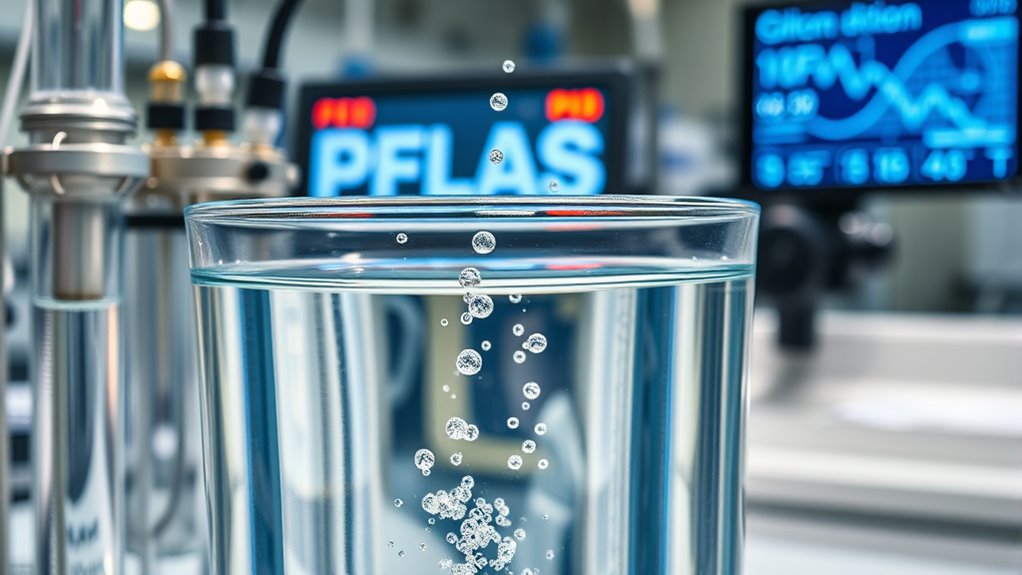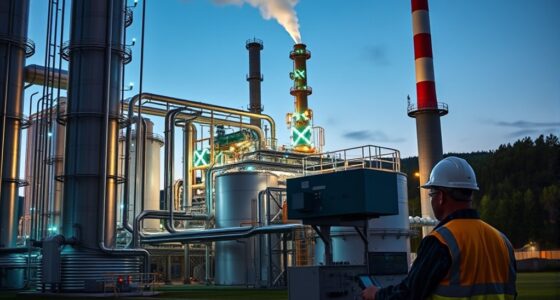Modern water treatment chemicals and membrane technologies are making it easier to remove stubborn pollutants like PFAS from your drinking water. Membranes such as nanofiltration act as tiny sieves, effectively rejecting PFAS molecules while allowing water through. At the same time, advanced adsorption media help target low-level contamination. These innovations increase efficiency, reduce costs, and improve water safety. Keep exploring to discover how ongoing advances continue to enhance your access to clean, safe water every day.
Key Takeaways
- Nanofiltration membranes effectively remove PFAS by acting as molecular sieves, allowing water to pass while rejecting contaminants.
- Advanced water treatment chemicals enhance membrane performance and longevity, improving PFAS removal efficiency.
- PFAS adsorption media and resins complement membrane filtration, targeting low-level contamination for comprehensive purification.
- Innovations in membrane materials and coatings increase durability, reduce maintenance, and support stricter safety standards.
- Ongoing technological advances in chemicals and membrane design ensure safer, cleaner drinking water and meet regulatory requirements.

Have you ever wondered how water systems keep drinking water safe and clean? It’s a complex process that relies heavily on advanced treatment methods and innovative chemicals designed to remove contaminants. One of the most challenging pollutants today is PFAS—per- and polyfluoroalkyl substances—which are notoriously difficult to eliminate because of their chemical stability and persistence in the environment. To combat this, water treatment facilities are turning to cutting-edge technologies, such as nanofiltration membranes, to effectively remove PFAS from drinking water supplies.
Nanofiltration membranes are a breakthrough in water treatment because they operate at a molecular level, acting like a sieve that filters out contaminants based on size and charge. These membranes are particularly effective against PFAS compounds due to their ability to reject even the smallest molecules. When water passes through nanofiltration membranes, the PFAS molecules are left behind, preventing them from reaching consumers. This process is more efficient than traditional filtration methods because it targets a wide range of contaminants, including organic compounds, heavy metals, and pesticides, while maintaining a relatively high flow rate. As a result, nanofiltration is increasingly being adopted as a primary barrier against PFAS contamination, ensuring safer drinking water.
Nanofiltration membranes filter contaminants at a molecular level, effectively removing PFAS and ensuring safer drinking water.
Beyond physical filtration, PFAS adsorption plays a vital role in water treatment strategies. This method involves using specialized media or resins that attract and hold onto PFAS molecules, effectively removing them from the water. PFAS adsorption is especially useful for treating water that contains low levels of these chemicals or for polishing water after other filtration processes. It can be integrated into existing treatment systems, making it a flexible and cost-effective option for utilities aiming to meet tightening regulations. Combining nanofiltration membranes with PFAS adsorption provides an all-encompassing approach, addressing different types of contaminants and ensuring water quality.
The ongoing advancements in membrane technology and adsorption techniques are transforming how water treatment plants tackle PFAS. New materials and coatings are improving membrane lifespan and resistance, reducing operational costs and maintenance needs. Meanwhile, innovations in adsorption media increase capacity and selectivity for PFAS, making removal more efficient. These membrane advancements are crucial in the fight against contamination and are helping utilities meet stringent safety standards and protect public health. You can feel confident that the water you drink is becoming safer, thanks to these scientific and engineering breakthroughs that continually enhance treatment processes and chemical applications.
Frequently Asked Questions
How Do PFAS Chemicals Impact Long-Term Human Health?
You should know that PFAS chemicals pose significant health risks, especially with long-term exposure. They can accumulate in your body, leading to toxicity levels that increase the risk of health issues like cancer, liver damage, and immune system problems. The toxicity levels vary, but consistent exposure raises concerns about chronic health effects. it is crucial to stay informed and minimize contact with these chemicals to protect your long-term health.
Are There Environmentally Friendly Alternatives to Traditional PFAS Removal Chemicals?
Yes, there are environmentally friendly alternatives to traditional PFAS removal chemicals. You can consider biodegradable alternatives that break down naturally without harming ecosystems. Additionally, natural filtration methods, like activated charcoal or biofiltration, effectively remove PFAS while being sustainable and less toxic. Using these options helps protect the environment and reduces your reliance on harmful chemicals, making water treatment safer for both humans and ecosystems.
What Are the Latest Innovations in Membrane Technology for PFAS Filtration?
Killing two birds with one stone, recent innovations in membrane technology boost PFAS filtration. You’ll find nanofiltration membranes excel at removing these contaminants, offering high efficiency and durability. Meanwhile, graphene oxide filters push the envelope further with enhanced selectivity and flow rates. These advancements make PFAS removal more sustainable and cost-effective, helping you stay ahead in water treatment while protecting the environment.
How Cost-Effective Are Advanced Membrane Systems for Large-Scale Water Treatment?
Advanced membrane systems are generally cost-effective for large-scale water treatment when you conduct a thorough cost analysis and consider their long-term benefits. They may have higher initial setup costs, but their efficiency in removing PFAS makes them economically feasible over time. You’ll find that their durability, reduced chemical usage, and lower operational expenses contribute to their overall economic viability, especially when addressing widespread contamination issues.
What Regulatory Changes Are Expected Regarding PFAS Levels in Drinking Water?
Like a watchful lighthouse guiding ships, regulatory agencies are tightening PFAS limits in drinking water. You can expect stricter standards, emphasizing regulatory compliance and updated chemical standards. Governments aim to reduce health risks, so future regulations will likely lower allowable PFAS levels, pushing water providers to adopt advanced treatment solutions. Staying ahead means preparing for these changes now, ensuring your systems meet evolving safety and quality benchmarks.
Conclusion
As you explore water treatment chemicals and membrane advances, it’s inspiring to realize how these innovations can protect your community’s health. Sometimes, breakthroughs seem to come just when you need them most, reminding us that progress often arrives quietly but powerfully. By staying informed and supporting these advancements, you play a crucial role in safeguarding clean water for generations to come—proof that even small efforts can lead to big change.








